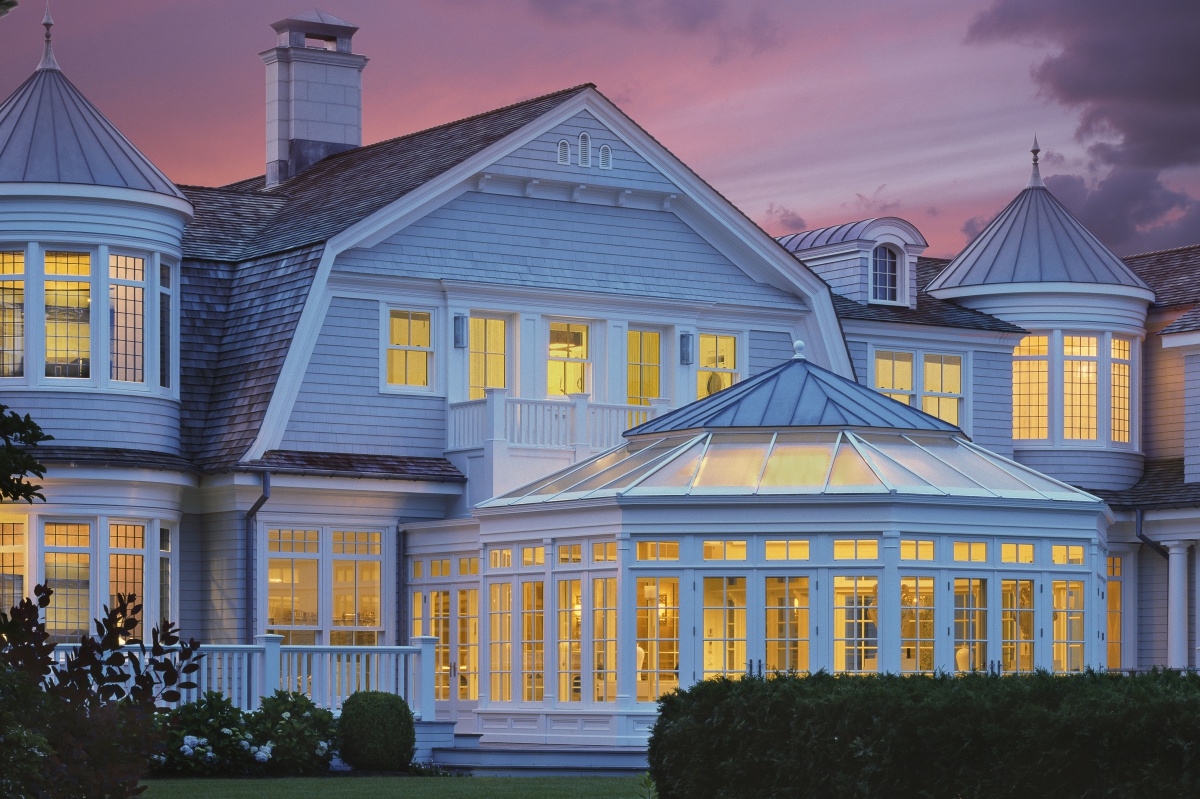Architect Bruce Nagel Talks Inspiration, Aspiration and Designing Dreams

“What I enjoy about doing homes has almost nothing to do with architecture.”
Perhaps not exactly the words you might expect from one of the leading architects in the Hamptons. But listen to Bruce Nagel talk about his craft, his community, for five minutes—maybe even five seconds—and you realize that those are exactly the right words.
“It has all to do with my relationship with my client,” he continues. “I really enjoy the process of working with a client who is totally devoted—and they almost always are—to making a beautiful home. I’ve done public buildings, institutional buildings, where you feel like all they care about are time and money. But people are passionate about their homes, and it’s that passion that I really love. So the idea is to try to find a way to take my talents and, in effect, hand them to a client and deliver to them a product that represents their desires and their vision and their dreams.”

Originally from San Antonio, Nagel came to the Hamptons to open an office some 30 years ago, with a master’s degree from Harvard and the independent spirit that reflects his Texas roots. He has built a reputation here—along with homes for clients ranging from A-list Hollywood types to business moguls—not with any single style, but, in fact, quite the opposite.
“What happens is most of the time, clients go to Brand X architect, because Brand X architect does the same glass box for every client, so they hire that person because they don’t have to think,” he says. There is no arrogance here, no disrespect of any kind, just the confidence forged over decades of doing things his way and succeeding. “They can just say, I know he’s going to give me that glass box, or I know he’s going to give me a gambrel-roof shingled house, or whatever the thing is they had in their head, and they go to that architect because he has that ‘signature style.’ I don’t work like that.
“I try to make sure that every house I do is unique, and it takes a client’s interaction to create that uniqueness,” he adds. “I can’t do that by myself. If you’re a painter and you like working on canvas and you use a wide brush, that means most of your paintings are going to look like big wide brush strokes. Most painters are going to stay in that same category. I try to get out of that, but it takes somebody to push me out of it.”
Back in 1986, Pulitzer-winning writer Wendy Wasserstein’s sister, Sandra Wasserstein Schweitzer, hired Nagel and wrote a story for him, describing the home she wanted to live in, and how she pictured living there. It gave him inspiration for not only that house, but for a new approach to future projects—asking clients to write a narrative that captured their vision, down to whatever detail they imagined.
War and Peace isn’t necessary, but Nagel asks for as much detail as possible, rather than just a list of “3 bedrooms, 2 bathrooms, blah blah blah,” he says. “If you can put an adjective in front of some of those words, it’s really helpful. As an architect—and I’ll throw myself into the area of being an artist—I’m actually creating and painting a piece of space that is a reflection of what people want. What they want is four walls, but there are other things to the four walls. I oftentimes say I’m kind of like a stage set designer. I’m designing a space for people to kind of play out their lives. And I need to know the story of the play.”
Sometimes that drama, or comedy, has surprising elements, particularly in an I-can-ask-for-anything market such as the Hamptons. Like the time he did a house for a single woman with kids and she provided an interesting detail in her narrative. “I think with the exception of the bathrooms, every room in some fashion had a requirement for a table and eating. It was like, she ate in the bedroom, she ate on the deck off her bedroom, she ate in the living room, she ate in the kitchen, she ate in the dining room…” he trails off with a chuckle.
Another client once told Nagel that she wanted a beautiful house, with a beautiful kitchen, but that she’d never actually cook in it. “About three years later, the couple divorced, and I was brought back into the house by the potential buyer,” he recounts. “And lo and behold, the stickers that were inside the stove, and the wraps around the grates—there was not one thing in that stove that had been touched. When she said she didn’t cook, she really meant it. That house, by the way, is the house that Sean Combs lives in now, so when he bought that house, he basically bought a brand new kitchen, even though it was a few years old.”
***
Step outside. Step to your window. Look up and out. You’ve just seen the timeless Hamptons quality that still fuels Nagel, the same thing that called the likes of Jackson Pollock and Willem de Kooning and countless others here. “One of the reasons people for a hundred-plus years have been wanting to come out here is for the natural beauty and the light,” he says. “We didn’t have all these artists come out here because it was just some place to go and smoke pot. They really liked the light—it’s pretty special. And how that light gets translated is it’s reflecting off the ocean, and then into the clouds, and onto the sky and back down to the soil. It’s a unique lighting situation.
“And how architects respond to that, and how homeowners respond to that, is they want big windows,” he continues. “They want to see the out of doors inside their home. So even if somebody asks me to design a traditional-oriented home, it’s inevitable that they want massive windows—maybe in the back or the sides, somewhere, to bring in all that natural exterior beauty, that beautiful light. It doesn’t have to be a glass contemporary house to have that—everybody wants that.”
Beyond looking out on magnificent vistas, what more and more people seem to desire in the Hamptons, Nagel notes, is size. The ever-escalating square footage of homes is the biggest change he’s witnessed over the years, and it’s a trend he feels can meander into the realm of the absurd. “When I first came out here, it was not uncommon for someone to hire me to design a 1,500- or 2,000-square-foot home. I probably haven’t been asked to design a 2,000-square-foot home in maybe 15 years. Which is silly, because, what are you doing in these big things? It’s people building 10,000-square-foot houses and having four occupants in them.”
When Nagel was teaching architecture years ago, one of his favorite design exercises for early architectural students was to give them a Frank Lloyd Wright floor plan—not revealing its creator—and see what they would make the house look like from the outside. “It’s a famous, famous plan—every architect would have drawn the exact same elevation if they knew whose plan that was,” he says. “It’s amazing how creative people were in interpreting that piece of work. What that means to me is, there aren’t any correct kind of formulas for architecture. And what I would teach people today is, do your own thing. Be making unique architecture, because it’s there, and there are so many creative, talented architects who can do that. People should be pushing the envelope more.”
That’s not to say, however, that he gives credence to those whispers, sometimes something louder, about too many new homes going up on the East End looking too much the same, how it’s affecting the architectural state of the area. “Sometimes we can’t see beyond the trees in the forest, and we have architecture here that is exemplary—that is beyond exemplary,” he says. “It so far exceeds what Middle America experiences that whenever anybody ever comes to me with ‘Oh poor us, we have houses that look alike,’ it’s like, are you kidding me?”
Nagel is the first to admit that beauty is in the eye of the beholder. That goes for a home that is no further than the drafting table or one that has been around for generations. And it is a particularly important fact to remember, he insists, when talk turns to preservation of homes out here, notably those of noted architects.
“What I think is really good architecture and what you think is really good architecture may be diversely different,” he says. “So to then have some bureaucrat come in and say ‘This is reserved for not being modified, and you can do whatever you want to that’ starts to become very kind of subjective, and very, let’s say, in the moment. So today people are more interested in more contemporary architecture, people would be interested in preserving that Phillip Johnson house. Fifteen years ago, that house could have gotten torn down because nobody cared about that style. So when you get into this area of appropriateness to remove something or preserve something, boy, does that get to be difficult.”
He makes a quick add to this line of conversation, noting that preservation of the past is essential. It’s just a matter of the right approach. “I think it’s a shame when really historical things get demolished. I think municipalities need to find creative ways to work with people to not just say no, no, no, but let’s sit down at the table together to figure out a way to give you what you want to do and also help preserve our history.
Looking back is all well and good, but Nagel also has his eye on what tomorrow brings. “I’m just about to turn 65, and I actually started working for an architect when I was 16 years old, so in another year I’ll have done this for 50 years,” he says, and there isn’t a trace of anything but genuine enthusiasm when he talks about his upcoming projects.
“Probably the most exciting thing I have going right now is I’ve been hired by an Indian family, who live in India, to design a house for them in Saddle River, New Jersey, Gin Lane, Southampton, and in the countryside of India. So three homes for this one family. It’s exciting to work with the same family repeatedly and be in completely different environments to think about the architecture that you have to make appropriate for each setting.” He’s also designing a Tuscan villa for a property in Westhampton, with imported tiles for the roof from Italy, and, potentially stucco artisans to be brought in from Europe.
The attention to, and appreciation of, those kinds of small points goes to the core of one of Nagel’s driving principles: God is in the details. The architect cites inspirations from Michelangelo to Le Corbusier, but the aphorism attributed to Ludwig Mies van der Rohe, an architect who was trained in Germany and came to the United States right before the Second World War, holds an especially valued place.
“What it really is talking about is that, architecture is made up of many different layers, or many different aspects,” Nagel says. “Fundamentally, the most important thing in architecture is to make the space appropriate, meaning that it’s the right scale and right proportion and so forth, but when you get beyond all that, what that term means, God is in the details, is what is the doorknob? What is the baseboard? What is the actual weight of the door? What is the handle that you grab to turn the hot and cold water on?
“It’s the detail, the stuff you actually touch as a human being and physically have a relationship with as a human being. Not the overall big lofty concepts, but the actual humanity that architecture is. That’s what it’s about.”



